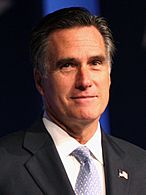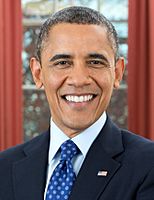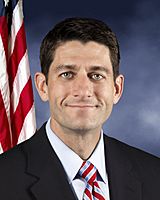United States presidential election, 2012 facts for kids
|
|||||||||||||||||||||||||||||
|
|||||||||||||||||||||||||||||
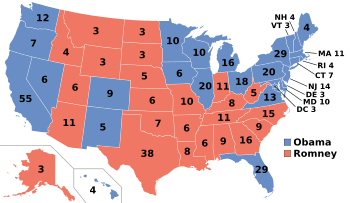
Presidential election results map. Blue denotes states won by Obama/Biden. Red denotes states won by Romney/Ryan. Numbers indicate the number of electoral votes allotted to each state.
|
|||||||||||||||||||||||||||||
|
|||||||||||||||||||||||||||||
The 2012 United States presidential election happened on November 6, 2012. In this election, Americans voted for their next president and vice president. They also voted for members of the U.S. Senate and U.S. House of Representatives.
Barack Obama and his running mate, Joe Biden, were elected for their second term. News channels announced their win late on November 6. Mitt Romney of the Republican Party accepted his loss early on November 7. Gary Johnson of the Libertarian Party came in third place.
Contents
How Electoral Votes Changed
The number of Electoral College votes each state gets can change. This happens after the U.S. Census, which counts everyone in the country. Between the 2008 and 2012 elections, some states gained votes, and others lost them.
|
States Gaining Votes
|
States Losing Votes
|
Party Conventions
Before the election, major political parties hold national conventions. This is where they officially choose their candidates for president and vice president.
In 2012, the Republican Party held its convention in Tampa. It took place in late August. The Democratic Party held its convention in Charlotte, North Carolina in early September. After the conventions, the chosen candidates from each party then compete against each other in the general election.
Main Candidates for President
Democrats
Barack Obama announced he would run for re-election on April 4, 2011. He faced some challengers in the Democratic primary elections. However, he won all 57 Democratic primaries. This meant he became the official Democratic nominee.
Democratic Nominees
| Democratic Party Ticket, 2012 | |||||||||||||||||||||||||||||
| Barack Obama | Joe Biden | ||||||||||||||||||||||||||||
|---|---|---|---|---|---|---|---|---|---|---|---|---|---|---|---|---|---|---|---|---|---|---|---|---|---|---|---|---|---|
| for President | for Vice President | ||||||||||||||||||||||||||||
| 44th President of the United States (2009–present) |
47th Vice President of the United States (2009–present) |
||||||||||||||||||||||||||||
| Campaign | |||||||||||||||||||||||||||||
Other Democratic Candidates
Some other people also ran for the Democratic nomination. They included:
- John Wolfe, Jr., an attorney from Tennessee
- Darcy Richardson, a historian from Florida
- Bob Ely, an entrepreneur from Illinois
- Randall Terry, from West Virginia
-
Attorney
John Wolfe, Jr.
of Tennessee -
Historian
Darcy Richardson
of Florida -
Randall Terry
of West Virginia
Republicans
Republican Nominees
| Republican Party Ticket, 2012 | |||||||||||||||||||||||||||||
| Mitt Romney | Paul Ryan | ||||||||||||||||||||||||||||
|---|---|---|---|---|---|---|---|---|---|---|---|---|---|---|---|---|---|---|---|---|---|---|---|---|---|---|---|---|---|
| for President | for Vice President | ||||||||||||||||||||||||||||
| 70th Governor of Massachusetts (2003–2007) |
U.S. Representative from Wisconsin (1999–present) |
||||||||||||||||||||||||||||
| Campaign | |||||||||||||||||||||||||||||
Republicans Who Left the Race
Many Republicans started campaigns for president in 2011. However, most of them later stopped their campaigns. Here are some of the candidates who withdrew:
- Ron Paul, a U.S. Representative from Texas.
- Fred Karger, a political consultant from California.
- Newt Gingrich, a former U.S. Speaker of the House from Georgia.
- Rick Santorum, a former senator from Pennsylvania.
- Buddy Roemer, a former governor of Louisiana.
- Rick Perry, the Governor of Texas.
- Jon Huntsman, Jr., a former U.S. ambassador to China and former governor of Utah.
- Michele Bachmann, a U.S. Representative from Minnesota.
- Gary Johnson, a former governor of New Mexico.
- Herman Cain, a businessman from Georgia.
- Thaddeus McCotter, a U.S. Representative from Michigan.
- Tim Pawlenty, a former governor of Minnesota.
-
U.S. Representative
Ron Paul
of Texas
(campaign) -
Political consultant and gay rights activist
Fred Karger
of California -
Former House Speaker
Newt Gingrich
of Georgia
(campaign) -
Former Senator
Rick Santorum
of Pennsylvania
(campaign) -
Former Governor
Buddy Roemer
of Louisiana
(campaign) -
Governor
Rick Perry
of Texas
(campaign) -
Former Ambassador
Jon Huntsman
of Utah
(campaign) -
U.S. Representative
Michele Bachmann
of Minnesota
(campaign) -
Former Governor
Gary Johnson
of New Mexico
(campaign) -
Businessman
Herman Cain
of Georgia
(campaign) -
U.S. Representative
Thaddeus McCotter
of Michigan
(campaign) -
Former Governor
Tim Pawlenty
of Minnesota
(campaign)
In the middle of 2011, many Republicans were running. These included Michele Bachmann, Herman Cain, Newt Gingrich, Ron Paul, Jon Huntsman, Rick Perry, Mitt Romney, Rick Santorum, Gary Johnson, Buddy Roemer, Thaddeus McCotter, and Tim Pawlenty. Some well-known figures like Scott Brown and Sarah Palin were thought to be possible candidates, but they decided not to run.
The Republican candidates started having debates in May 2011. In August, a poll called the Ames Straw Poll was held. Bachmann won, and Paul came in second. After this poll, Tim Pawlenty and Thaddeus McCotter stopped their campaigns.
Rick Perry then became the "frontrunner," meaning he had the most support in polls. But his support dropped after some difficult debates. In one debate, he forgot a government department he wanted to remove.
Later, Herman Cain became the new frontrunner for a few months. He had an economic plan called "9-9-9." This plan would replace all current taxes with a 9% income tax, a 9% national sales tax, and a 9% business tax. However, he struggled in debates about foreign policy. Cain left the race on December 3, 2011.
After Cain, Newt Gingrich and Mitt Romney were the main competitors. But Gingrich soon lost much of his support. Gary Johnson left the Republican race on December 28, 2011. He decided to run for the nomination of the Libertarian Party instead.
In January 2012, Bachmann, Huntsman, and Perry dropped out after not doing well in the early primary elections. However, Rick Santorum had a surprise win in Iowa. Gingrich also won in South Carolina.
For February, March, and early April, Rick Santorum was Mitt Romney's main opponent. But on April 10, Santorum announced he was leaving the race. He had won 11 primaries compared to Romney's 23. Buddy Roemer also dropped out in February.
After Santorum left, most people expected Mitt Romney to win the Republican nomination. His two remaining opponents, Newt Gingrich and Ron Paul, stayed in the race for a while. Gingrich dropped out on May 2. Paul continued his campaign even after the Republican National Convention.
Santorum and Gingrich told their supporters to vote for Romney at the convention. At the Republican National Convention, Romney easily won the nomination. The convention also chose Paul Ryan as Romney's running mate for vice president.
Other Candidates
Besides the main Democratic and Republican candidates, other people also ran for president. These included Virgil Goode, Roseanne Barr, Rocky Anderson, and Tom Hoefling.
Four other parties nominated candidates who could be voted for in many states. These parties and their candidates were:
Libertarian Party
- Gary Johnson, a former governor of New Mexico. His running mate was Jim Gray, a retired judge from California.
Green Party
- Jill Stein, a medical doctor from Massachusetts. Her running mate was Cheri Honkala, a social organizer from Pennsylvania.
Constitution Party
- Virgil Goode, a former U.S. congressman from Virginia. His running mate was Jim Clymer from Pennsylvania.
Justice Party
- Rocky Anderson, a former mayor of Salt Lake City and a founder of the Justice Party, from Utah. His running mate was Luis J. Rodriguez from California.
Other Candidates Gallery
-
Gary Johnson
(campaign) -
Jill Stein
(campaign) -
Virgil Goode
(campaign)
Election Polls
Many polls were taken to guess who would win the election. Most polls showed Obama ahead of Romney. However, polls taken between the first and second presidential debates sometimes showed Romney doing better.
When looking at individual states, Obama usually won the states he won in 2008. Republicans usually won the states that John McCain won in 2008. The states of Indiana, North Carolina, and Nebraska's second congressional district were the main exceptions to this pattern.
Election Results by State
The table below shows the final results of the election. It includes the number of electoral votes each candidate received, how many states they won, and their total popular votes.
| Candidate (Party) | Electoral votes |
States carried* |
Popular vote |
Pct. | |
|---|---|---|---|---|---|
| Obama (Democratic) | 332 | 27 | 65,915,796 | 51.06% | |
| Romney (Republican) | 107 | 24 | 60,933,500 | 40.20% | |
| Johnson (Libertarian) | 0 | 0 | 1,275,971 | 0.99% | |
| Stein (Green) | 0 | 0 | 469,628 | 0.36% | |
| Goode (Constitution) | 0 | 0 | 122,388 | 0.09% | |
| Barr (Peace and Freedom) | 0 | 0 | 67,326 | 0.04% | |
| Anderson (Justice) | 0 | 0 | 43,018 | 0.03% | |
| Hoefling (America's) | 0 | 0 | 50,628 | 0.03% | |
| Others | 0 | 0 | 217,148 | 0.17% | |
| Total | 538 | 51 | 129,085,403 | 100% | |
| * includes District of Columbia | |||||
Note: The popular vote count shown here is based on early numbers and may not include every single vote.
State Projections
When you see "Consensus projection," it means that many news organizations agreed on who would win that state. A "projection" is when someone predicts the outcome of the election. "EV" means Electoral Vote, which comes from the Electoral College.
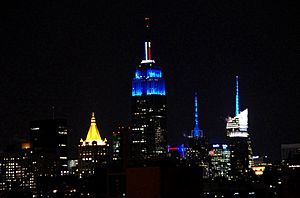
- Alabama – 9 EVs, Romney (Consensus projection)
- Arkansas – 6 EVs, Romney (Consensus projection)
- Arizona – 11 EVs, Romney (CNN projection)
- California – 55 EVs, Obama (CNN projection)
- Connecticut – 7 EVs, Obama (Consensus projection)
- Colorado – 9 EVs, Obama (AP projection)
- Delaware – 3 EVs, Obama (Consensus projection)
- Florida - 29 EVs, Obama (Consensus projection)
- Georgia – 16 EVs, Romney (Consensus projection)
- Hawaii – 4 EVs, Obama (CNN projection)
- Idaho – 4 EVs, Romney (Consensus projection)
- Illinois – 20 EVs, Obama (Consensus projection)
- Indiana – 11 EVs, Romney (Consensus projection)
- Iowa – 6 EVs, Obama (CNN projection)
- Kansas – 6 EVs, Romney (Consensus projection)
- Kentucky – 8 EVs, Romney (Consensus projection)
- Louisiana – 8 EVs, Romney (Consensus projection)
- Maine – 4 EVs, Obama (Consensus projection)
- Maryland – 10 EVs, Obama (Consensus projection)
- Massachusetts – 11 EVs, Obama (Consensus projection)
- Michigan – 16 EVs, Obama (Consensus projection)
- Minnesota – 10 EVs, Obama (CBS projection)
- Mississippi – 6 EVs, Romney (Consensus projection)
- Missouri – 10 EVs, Romney (CBS projection)
- Montana – 3 EVs, Romney (Consensus projection)
- Nebraska – 3 EVs, Romney (Consensus projection) (4th and 5th Electoral votes Consensus projection)
- Nevada – 6 EVs, Obama (ABC projection)
- New Hampshire – 4 EVs, Obama (Consensus projection)
- New Jersey – 14 EVs, Obama (Consensus projection)
- New Mexico – 5 EVs, Obama (NBC projection)
- New York – 29 EVs, Obama (Consensus projection)
- North Carolina – 15 EVs, Romney (CNN projection)
- North Dakota – 3 EVs, Romney (Consensus projection)
- Ohio - 18 EVs, Obama (CNN projection)
- Oklahoma – 7 EVs, Romney (Consensus projection)
- Oregon – 7 EVs, Obama (CNN projection)
- Pennsylvania – 20 EVs, Obama (Consensus projection)
- Rhode Island – 4 EVs, Obama (Consensus projection)
- South Carolina – 9 EVs, Romney (Consensus projection)
- South Dakota – 3 EVs, Romney (Consensus projection)
- Tennessee – 11 EVs, Romney (Consensus projection)
- Texas – 38 EVs, Romney (Consensus projection)
- Utah – 6 EVs, Romney (CNN projection)
- Vermont – 3 EVs, Obama (Consensus projection)
- Virginia – 13 EVs, Obama (CNN projection)
- Washington, D.C. – 3 EVs, Obama (Consensus projection)
- Washington – 12 EVs, Obama (CNN projection)
- West Virginia – 5 EVs, Romney (Consensus projection)
- Wisconsin – 10 EVs, Obama (Consensus projection)
- Wyoming – 3 EVs, Romney (Consensus projection)
Note: The state of Florida's winner was not announced until November 10 because the race was extremely close.
Images for kids
-
Mitt Romney on the campaign trail.
-
President Obama talks with Ron Klain during presidential debate preparations. Senator John Kerry played the role of Mitt Romney.
-
President Obama casts his ballot in Chicago.
-
How states voted differently from 2008 to 2012.
-
The Obamas and the Bidens walk on stage at their election night celebration in McCormick Place, Chicago.
See also
 In Spanish: Elecciones presidenciales de Estados Unidos de 2012 para niños
In Spanish: Elecciones presidenciales de Estados Unidos de 2012 para niños



